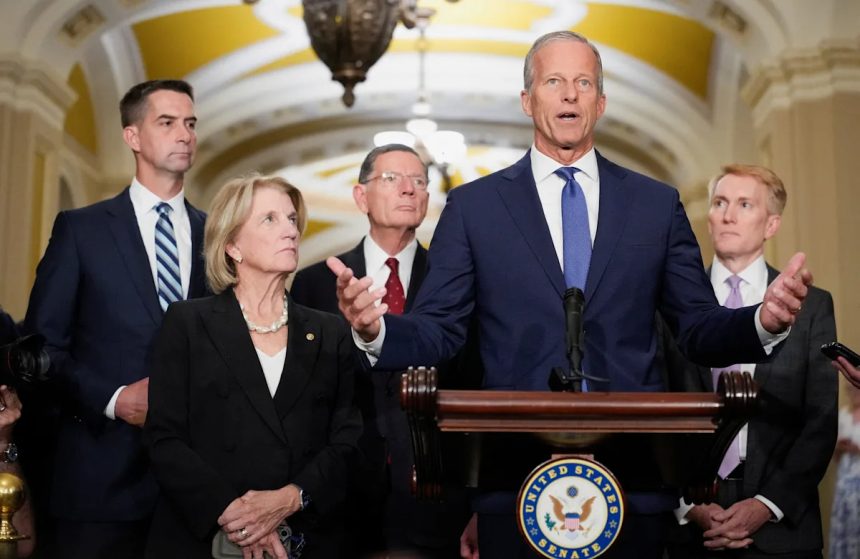America is in the midst of a vast political realignment — not entirely caused by Donald Trump, but certainly accelerated by him. And the biggest indicator of how someone will vote is now based on education. Went to a four-year college? You’re likely backing the Democrat. Skipped it? There’s the Republican lever.
These are some of the most important observations in a new report on the state of American politics ahead of the 2026 midterms from Doug Sosnik, a former senior adviser to President Bill Clinton and now at the Brunswick Group, a global advisory firm. Sosnik has become well known in Washington for his slide decks of political analysis, and this memo and slide deck lay bare the degree to which education polarization has reshaped American politics.
In 2024, Democrats carried 14 of the 15 most college-educated states, while Republicans captured 14 of the 15 least college-educated states (Utah and New Mexico, respectively, bucked the trend).
A year out from the midterms and with Trump’s approval rating on the decline, Sosnik told POLITICO Magazine that he expects Democrats to do well. The House is within reach for the party, though the Senate will obviously be tougher to take.
But Democrats would be foolish to think they’ve solved their problems if they do succeed in 2026. College-educated Americans are higher propensity voters — they’re more likely to turn out in a midterm election. When the next presidential election arrives, the makeup of the electorate will once again shift.
“2028 and 2026 are completely different,” he said.
This interview has been edited for length and clarity.
As we look through this report, what results jumped out to you as something different from the political consensus heading into 2026?
There’s been a rule of thumb, actually going back to the 1950s but certainly in the period of time that I’ve been in politics now for 40 years, that in midterm elections, the president’s job approval is the single best predictor of the outcome. And what also has happened in the last 20-25 years is that the president’s job approval around Labor Day of their first year in office tracks pretty closely to their job approval for their entire term of office. And Trump, more than any other president, has a much narrower band between his low marks and his high marks of job approval.
If you go back to 1994, when Clinton had the same job approval as Trump does now, it was the biggest midterm election swing against the incumbent party since at least the early 1970s. And then in 2010, Obama had the same job approval as Trump, and that turned out to be a bigger swing against the incumbent party, I think the biggest since World War II.
But due to structural changes in our politics, which are largely due to a realignment in our politics based on education levels, even if the Democrats were to have a really great election cycle in the midterms, there’s going to be a limit to how many seats they can win back due to these structural changes.
If you look at Trump’s job approval on issues, he’s underwater on everything, particularly way, way lower now on the economic ratings, on inflation, and even immigration now is underwater. So you would think that his total job approval, currently around 44 percent, would be lower.
The bottom line is based on historical standards, Trump and the Republicans should be headed to a really bad midterm election. But because of these changes in our politics, due to realignment based on education, they’ll be more insulated than they would have been in the past from a tsunami-type of midterm.
Trump’s approval rating suggests Republicans are in for a rough 2026, at least in the House. But Biden and Democrats managed to largely overcome very similar numbers in 2022. What’s the likeliest outcome next year, and what would Republicans need to keep losses to a minimum?
We’ve only had seven swing states in the last three presidential elections. The other 43 are not. And the reason the other 43 are not is they skew towards either a high level of college education or low level of college education. And that’s why 86 percent of the states in this country are not competitive. What distinguishes almost all of those seven states is that they all tend to be in the middle on education.
So in 2022, there were probably three factors that helped Democrats. The first was, I do think that the Roe decision was a factor, especially for the higher percentage of the electorate that is college-educated that votes in the midterms. The second thing is that the basket of states in the Senate that were on the ballot were disproportionately in those battleground states where it wasn’t a layup for either party. The third reason is that the states overall were more favorable to Democrats. For instance, they picked up two governors’ races because you had Republicans in Massachusetts and Maryland, two of the most highly educated states in the country. So, I think it was the basket of states that enabled the Democrats to defy history. Those same conditions won’t be available to Republicans in 2026.
The Senate is obviously tougher for Democrats. What are their chances at winning back a majority?
Right now, there are only six Senate races that are considered highly competitive or somewhat competitive, and three of them are held by Democrats. So that’s a huge advantage for the Republicans in terms of limiting their losses.
Now for the Democrats to take the Senate back, they have to enlarge the map in Texas and Ohio. I think there are some reasons so far, at least, that there should be some concern by Republicans. They’ve done a poor job of recruitment. New Hampshire, which was considered a toss-up by the Cook Political Report, now leans Democratic because of poor candidate recruitment by the Republicans. They’ve done a poor job of recruitment in Georgia as well. And they’ve got a ticking time bomb in Texas, where if Attorney General Ken Paxton becomes the nominee, that state all of a sudden becomes winnable. The Democrats have also done a very good job in recruitment getting, without question, the best possible candidate in North Carolina and Ohio.
How does the fact that Trump is not a regular politician but a movement leader affect how the midterms might shake out?
There is some historical analog which should give some heartburn to Republicans. In almost 50 years, I think there have been probably three people that have been what I call movement candidates — Reagan, which was a political movement, that was probably the last time our politics had been realigned that way. And then Obama and Trump, and what happened for both Obama and so far with Trump is that movements are, by definition, built around the popularity of an individual, and that is largely proven to be not transferable in the case of Obama Democrats and in the case of Trump Republicans.
You look at Obama’s victory in 2008, I think it was the biggest political victory by a Democrat for president since Lyndon Johnson. If you look two years later, that was the biggest loss by a party since World War II. Because the people that voted for Obama were attracted to Obama. They weren’t necessarily attracted to the Democratic Party. Republicans got battered in 2018, lost over 40 seats in the House, and they underperformed considerably in 2022. So there’s no evidence up until now that this movement to Trump has transferred to other Republicans when he’s not on the ballot.
One of the starkest parts of your deck was the degree to which Democrats are now relying on college-educated voters, who also tend to participate more in midterm elections. Does this combination mean they have a better chance next year in a lower turnout scenario?
Since I’ve been in politics, the world has turned on its side on that question. Politics is a lagging indicator. Starting in the 1960s with the Vietnam War, and then the economic divide between the people with and without money in the 70s, it didn’t surface in our politics until 1992, when Ross Perot got 19 percent of the vote, driven by rural non-college voters who have been screwed by the transformation of our economy. Trump was a symptom of and not a cause of this, but he did accelerate the completion of these trends that formed long before he ever thought about running for president. His 2016 election was the culmination of those trends, and his presidency helped reinforce them.
The 2018 midterms was the first election in this post-realignment world in which all of a sudden, midterm elections favor the Democrats because they’re the party of the college-educated and they’re the highest propensity voters. On average, the percentage of the electorate that’s college-educated is about four points higher in an off-year. And so 2028 and 2026 are completely different.
The 2026 midterms, for all of the challenges and problems the Democrats have going forward, those challenges can actually become an advantage in the midterms. But they are an increasing liability in the presidential. So I don’t think you should look at the midterms as a precursor to what’s going to happen in 2028, but amongst the advantages that the Democrats now have in the midterms next year is having a party full of college-educated people and higher propensity voters.
So, Democrats are in for some lean presidential years if they can’t reverse this trend.
Somebody asked me, what should the Democratic Party be doing to get back? My answer is threefold. The first is, presidents and nominees define parties. So us taking the White House back in 2028 is going to be hugely dependent on who we nominate. Do they have the right vision, the right temperament to be elected president?
The second thing we need to do is not take the bait on the social issues in which we are outside the mainstream. Not only where we are on these issues, but the fact that we spent a lot of time focused on them.
But the third factor, and the most important, we will never become a majority party again if we’re not able to attract non-college people to vote for us. If you take the history and the strength of the Democratic Party, we were the party that provided opportunities for people, if they worked hard, they could get ahead. And we’ve now had a half a century in which there’s an increasing number of people who believe that we no longer do that. So to me, the key for us is understanding we’re in a country in which 60 percent of the people don’t have a four-year college degree, the key for us is going to be whether we can attract non-college-educated voters to support us, and we need an agenda that will enable them, if they work hard, to get ahead.
We have a clear collection of swing states now. But if these trends continue, what other states could be up for grabs, and what current swing states might move more into one column or another?
2000 was the beginning of this correlation of education and voting. And so that was the first year that you saw, I think, five states that were traditionally Democratic not only move to the Republicans, but become part of the Republican base — Kentucky, Tennessee, Louisiana, Arkansas and West Virginia. And then you saw in the first decade a trend in which both Colorado and Virginia, because they’re highly educated voters, move to Democrats and Ohio and Iowa increasingly become Republican. They both have a low percentage of educated voters.
If you go back to your question, it depends on your frame of reference in terms of time. So, for instance, I’m quite confident that in a fast moving, fast growing state like Tennessee that is getting a huge growth and huge influx of people from other parts of the country, and a huge increase in the number of companies that are moving to Nashville, I believe that Tennessee will be a Democratic state in the future. Now, if you ask me when, I would say I don’t know, but maybe in 20 years.
You see these trends over time, and to me it’s clear where they’re going, but it’s less clear when we’re going to get there. In real time, a place like Nevada is quite interesting, because except for one election with Bush prior to Trump’s victory last year, they’ve voted for Democrats all the way going back to ‘92. But they’re really towards the bottom on education level. I could see a state like that moving more towards Republicans. I also think in these industrial Midwestern states that already had a higher percentage of non-college voters than the rest of the country, in their low-growth states, I think these could become more challenging for the Democrats in the future.
As a Democrat, the things that I’m looking at that concern me the most out of the 2024 election are the fact that education is now beginning to transcend race and ethnicity in determining how people vote, and the decline in young voters voting for Democrats.
There was an old saying that Democrats believed 20 years ago, which was that demography is destiny, and because all these young people and people of color and Hispanic people were all Democratic, these states with a high proportion of the population being Hispanic and young, they’re all eventually all going to be Democratic. Well, I’m not sure demography is destiny anymore.
I will say, though, that for younger people of all races and ethnicities, I think they don’t really believe in any of the people in power. I think they feel alienated from both political parties. And so I think they’re all completely up for grabs.
Do you have any other direct predictions about how 2026 will play out? Any specific races you’re watching?
In the House, if you’re looking at all the states considering mid-decade reapportion redistricting, that totals up to almost a third of the Electoral College. So at this point, it’s really difficult to make any predictions. The first question is how does the mid-decade redistricting come out? The range of outcomes is probably Republicans netting somewhere between plus four and plus nine seats. Then I’d look at these 13 Democratic-held seats that Trump carried in 2024. Then, I’d look at states with a bunch of competitive seats as barometers, including California, New York and Pennsylvania.
If you look at the Senate, I think you’re going into it assuming that it should be a good Democratic year. The question is, how good? There’s holding onto a first basket of states, that’s Michigan, New Hampshire and Minnesota. Then in a second tier, there’s holding Georgia and winning North Carolina and winning Maine — that would be maybe better than what we thought going in. Then you look at Texas and Ohio, and if you were to tell me nothing else about the election but that Democrats won Texas and Ohio, then I’ll tell you they had a great year.












